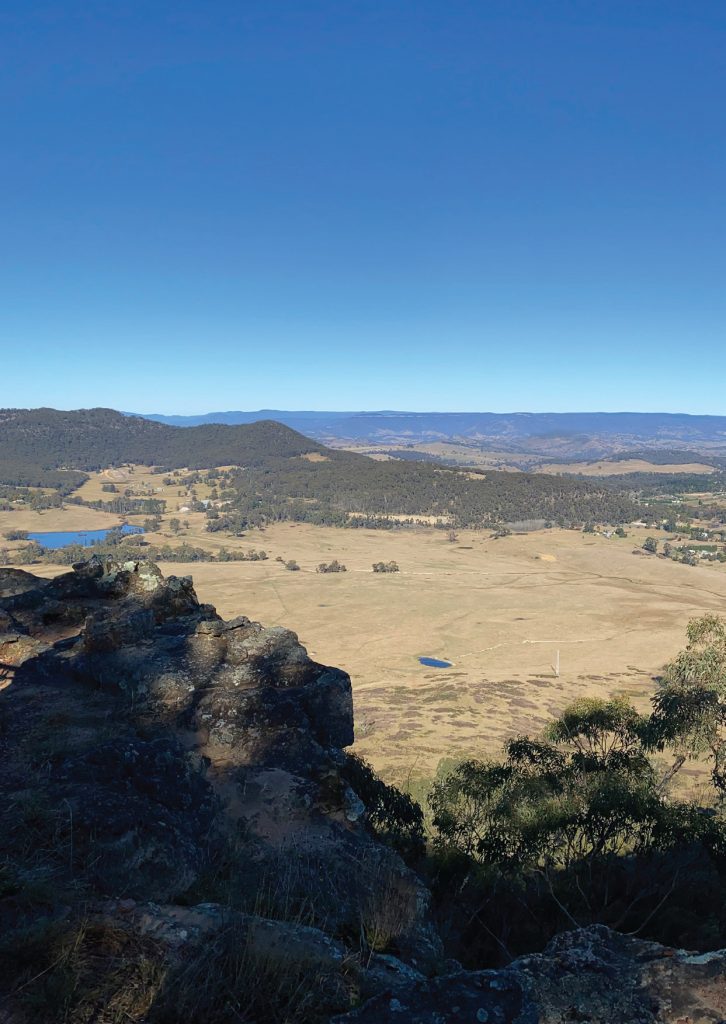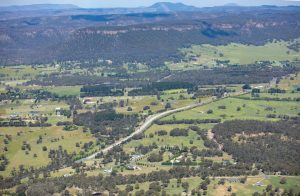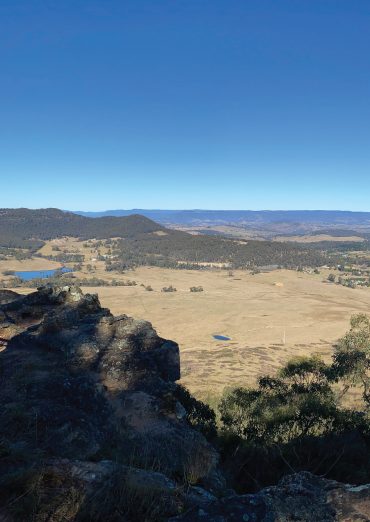Why is Hartley Valley so special?
The Hartley Valley, 125 kilometres west of Sydney, is a cultural landscape with remarkable natural, built and indigenous heritage value. The National Trust of Australia (NSW) recognised its value 35 years ago and listed the Hartley Valley Landscape Conservation Area on the National Trust Register.
The 14 kilometre Great Western Highway upgrade program between Little Hartley and Lithgow will have a significant upon this important landscape, and includes five bridges and overpasses, and two rest areas in the valley each capable of accommodating thirteen or more B Double trucks and a similar number of other vehicles
Hartley Valley Landscape Conservation Area is a significant and important cultural landscape; its National Trust listing notes, amongst other things, its patterns of early settlement, the historic early mountain passes which provide access down the stunning escarpment and the existence of a range of rare and endangered plant and animals in the Valley. Its listing on the (former) Register of the National Estate extolls its attributes as a cultural landscape, stating:
It has maintained exceptional continuity in patterns of life and industry, and as a result has a cultural landscape of integrity and authenticity, enriched with a large number of places of exceptional heritage value from first settlement until now.1
What is the issue?
Inadequate public consultation timeframes
Transport for New South Wales recently placed the 2,500 page Review of Environmental Factors (REF) for the highway upgrade proposal on public exhibition. The REF is a complex suite of documents that includes 17 accompanying Technical Studies.
The initial timeframe for public consultation was only 4 weeks to review, digest and respond to this vast array of documentation. Transport for NSW recognised the inadequacy of this timeframe and extended the consultation period from 21st December 2021 to 16th January 2022.
However, Schedule 1 (Division 3, Part 16) of the EP&A Act explicitly prohibits public exhibition of projects for the period between 20 December and 10 January (inclusive). Transport NSW’s extension of the project is not consistent with this provision.
The National Trust are calling for additional time to allow the community to read, digest, consult, review and provide meaningful and genuine input and feedback to this major proposal.
Impact on places of Heritage Significance
The REF confirms the significance of the Valley as a heritage place, noting the existence of 50 European heritage sites along the fourteen kilometre corridor and 19 indigenous sites, including an important possum skin processing site and a fire hearth that has reputedly been dated to about 5000 years old.
The Biodiversity Technical Study highlights a number of offsets required under the Biodiversity Conservation Act, 2016 in respect of endangered or threatened fauna, flora and fish species. However, while it makes reference to the potential impact of the project on instream habitat for fish, the report has completely omitted any consideration of the River Lett’s endangered platypus population. The National Trust also has serious concerns regarding the concept and process of Biodiversity Offsets, outlined in our recent submission to the NSW Parliamentary Inquiry into the Integrity of the Biodiversity Offsets Scheme.
The proposed upgrade will have a major impact on individual sites and species of significance, well as impacting the integrity and value of the overall Hartley Valley cultural landscape.
Inadequate Cultural Landscape Assessments
Despite the listed cultural landscape significance of Hartley Valley, the REF’s heritage technical studies do not adequately assess the significance of the landscape nor the overall, cumulative impact of the project on these values and simply identifies and assess individual sites only. Cultural landscapes are more than the sum of their parts – each element combines to create the highly significant cultural landscape and simply identifying and assessing individual sites gives an incomplete picture.
For example, whilst the Non-Indigenous Heritage Assessment (page IV) notes the “incredibly rich heritage landscape along the Great Western Highway” it does not reference the National Trust listing of this landscape, does not assess its significance in the report and does not assess the impact of the project on the cultural landscape.
Likewise, the Indigenous Heritage Assessment notes that Aboriginal community members have stated the entire area within the project is significant to Aboriginal people:
The Country of the Blue Mountains that the GWH travels through is an incredibly rich cultural landscape. Throughout this Country there are myriad places of cultural value and meaning including contemporary, historical, and traditional living places, trading places, rich resource areas, ceremonial places, women’s and men’s business sites, and a complex network of movement routes linking them all together.
The living importance of this Country to the Gundungurra, Wiradjuri, and Darug people is clear in the consultation section of this report.
It further states that:
The sites themselves, whilst being expected site types found within the project area … are of increased significance due to their rarity in an increasingly developed environment. Therefore, the regional Aboriginal cultural heritage values across the project would be reduced significantly by the cumulative impacts from the project if serious harm such as complete loss of a site was to occur.
The REF’s Urban Design, Landscape Character and Visual Impact Assessment also fails to identify and assess the impact of the proposal on the cultural landscape, despite Transport NSW’s Guidelines for landscape Character and Visual Impact Assessments explicitly requiring such reports to assess.
It is imperative that any REF assesses the impact of the proposal on the integrity and significance of the entire cultural landscape of Hartley Valley Cultural Landscape and other landscapes that the project will impact.
What is the National Trust doing?
- The National Trust’s President has written to the Minister for Transport noting the public consultation period is potentially not consistent with the EP&A Act Public Consultation provisions and has called for an urgent extension of the consultation period.
- The National Trust’s Advocacy team is reviewing the REF in detail so that we can make a detailed submission on the proposal, and our Lithgow Branch is also making a detailed submission.
What can YOU do to help?
Support our advocacy and ensure that this project and its impacts on such significant heritage are heard. Your options to respond are:
- If you are time poor, simply email gwhd@transport.nsw.gov.au and tell them that you don’t like the proposal – it’s that simple.
- If you have more time, you can use the information in this blog to write a more detailed submission that can also be submitted via email to gwhd@transport.nsw.gov.au
Every response counts – amplify the National Trust’s advocacy and respond now!
SEE THE REF DOCUMENTSLEARN ABOUT HARTLEY VALLEY’S HERITAGESUBMISSION TIPS & TRICKS
1 Australian Heritage Database. Hartley Valley, Great Western Hwy, Hartley, NSW, Australia. Accessed 30/12/20201 via https://www.environment.gov.au



 Twitter
Twitter Facebook
Facebook Linkedin
Linkedin Email
Email


Here we go again…another totally avoidable catastrophe looming. This is what happened on that most sacred mountain Bulahdelah… I for one will never recover from the horror and trauma of what happened here and the Guardian-Healing tree in particular, along with a few others… the implications of this event, imo the worst act of cultural/environmental vandalism by our government in Australia’s history (even worse than the Paradise Dam cultural genocide and ecocide) will be felt for many years to come.
Please contact me if you think I can help in any way….maureen
In 1841 Reverend William Branwhite Clarke, one of the earliest geologists in the colony, came across particles of gold near Hartley in the Blue Mountains.
In 1844 he mentioned it to Governor Gipps who reportedly said: ‘Put it away Mr Clarke or we shall all have our throats cut’.
The discovery of gold at Hartley is one of the least told stories yet the hill behind Hartley and at points all around the River Lett are littered with gold diggings. Behind the Church of England church these gold diggings follow the ridge that the church is founded on. I haven’t yet been able to establish this but it would appear that the Reverend Clarke observed these gold veins in the foundations of the soon to be built church and so there was reason to keep quite about just where the gold was discovered. Either way it would appear to me that no one has mapped what is an important part of our heritage and the final reason why convicts were no longer deported to Australia.
The ignorance of the avereage politician is frightening. Commerce is one thing but once it goes out into the country areas it becomes diabolical to the future of retaining such wonderful and original places around this great metropolis which is silently but insistently spreading out more and more into these wonderful places wich were and still are lovely day tours from the city and “wowed” over by overseas visitors to have such beauty and naturalness in a short distance for recreation, bushwalking, holidays and just family picnics along the lovely Lett River. I feel the problem starts at schools where pupils no longer are interested in their local history or of the surrounds of this great city which is extremely lucky to have great beaches in near reach and the defines of such beauty of the mountains with their promise of “fresh” air and exploring the wonderful valleys between the Katoomba range and that of the Oberon/Jenolan mountain range. And so our politicians are bred to only worry about commerce, or football and other sports, but care not a jot about what they are doing to God’s country.
There are alternatives for expansion if it is necessery – but care must be observed to keep our heritage and that of our indiginous families.
As a former resident of the region, I find the proposal appalling and don’t agree to its implementation.
There are so many potential cultural impacts on flora and fauna with this plan, to make one breathless.
Please provide more time for a detailed review, analysis and an alternative to be rigorously considered.